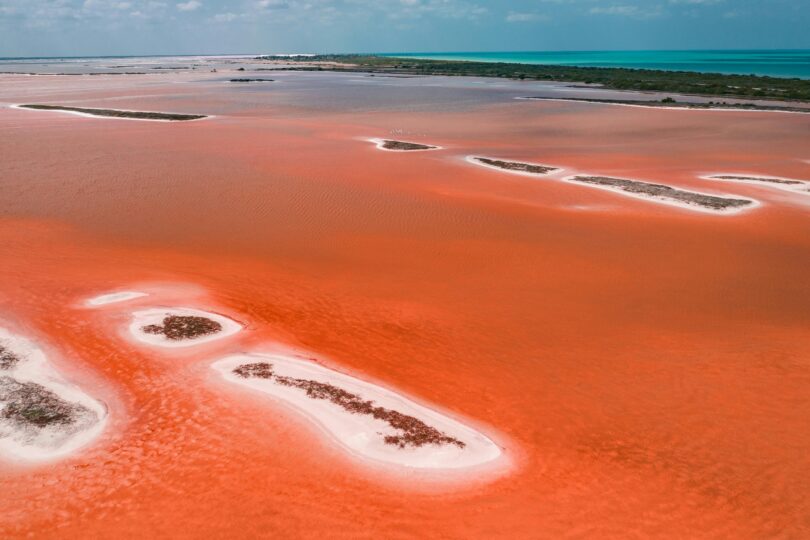“Red tides” Just hearing the term can conjure up images of dark waters and unsettling phenomena. But beyond the dramatic visuals, red tides are a real threat to both the ocean and those of us who live near the coast. So, what exactly are red tides, and why should we care?
Red tides are caused by an overgrowth of microscopic algae in the water. These tiny organisms, when they bloom in large numbers, can give the water a reddish or brownish hue – hence the name “red tide.” While this might sound like something from a science fiction movie, it’s a natural event that happens more often than we might realize. The trouble begins when certain conditions trigger these blooms to grow out of control, releasing harmful toxins that affect everything in their path.
How Do Red Tides Happen?
Red tides are often caused by a group of algae known as dinoflagellates. Under the right conditions – warm water temperatures, calm winds, and high nutrient levels – these algae can multiply at an alarming rate. They thrive on the nutrients found in water, often from pollution like agricultural runoff or wastewater. When this happens, the algae create a “bloom,” which can spread across large sections of the ocean, coloring the water and disrupting the delicate balance of marine life.
It’s not just the algae’s color that’s concerning – it’s the toxins they release into the water. These toxins can cause massive fish kills and, even more worryingly, contaminate shellfish, making them dangerous for humans to eat. And it doesn’t stop there – marine animals, like dolphins and sea turtles, can also be poisoned by the toxins, which can affect their nervous systems and even lead to death.
What Happens to Marine Life During Red Tides?
Imagine walking along a beach and seeing fish washing up on the shore. That’s what happens during a red tide. The algae release toxins that can suffocate marine animals and deplete oxygen in the water, creating a “dead zone.” This doesn’t just kill fish – it harms entire ecosystems. Coral reefs and seagrass beds, which are vital habitats for many species, are also at risk.
Marine mammals, birds, and even people can fall victim to the effects of red tides. For animals, the toxins can disrupt their systems, leading to death. For people, the danger lies in eating contaminated shellfish. If you’ve ever enjoyed oysters or clams, you know they can be a delicious treat – but not when red tides strike. Consuming shellfish affected by these blooms can lead to paralytic shellfish poisoning (PSP), which causes symptoms like nausea, dizziness, and, in extreme cases, paralysis or death.
Can Red Tides Be Caused by Climate Change?
The troubling reality is that red tides may be becoming more common – and climate change could be a part of the problem. Rising ocean temperatures and more intense storms are creating the perfect environment for these algae blooms to thrive. Warmer water speeds up the algae’s growth, while excess nutrients from agricultural runoff continue to flow into the oceans. Together, these changes could mean more frequent and intense red tides in the future, threatening not only marine life but also the livelihoods of those who rely on the ocean for food and income.
What Can We Do to Help Protect Our Oceans?
While red tides are a natural phenomenon, they’ve become a growing problem due to human activities. Reducing the amount of pollution we pour into the ocean is one of the most effective ways to prevent these algae blooms from taking over. Simple actions, like using fewer chemicals in farming, properly disposing of waste, and supporting eco-friendly policies, can make a big difference in protecting our oceans.
If you live near the coast, staying informed about red tides is crucial. Local authorities often issue warnings when these blooms are present, so be sure to follow any advisories and avoid eating shellfish from affected waters. During a red tide event, it’s also a good idea to limit your exposure to airborne toxins by staying indoors.
What’s Our Role in All of This?
Red tides serve as a stark reminder of how connected we are to the natural world and how our actions can ripple through ecosystems. By understanding the causes and effects of red tides, we can make informed choices that help protect marine life, safeguard our health, and preserve the beauty of our oceans. The more we raise awareness and take steps to reduce pollution, the better chance we have at mitigating the impact of these deadly blooms.
Red tides might seem like a far-off phenomenon, but the truth is, they’re happening more frequently, and their impact is far-reaching. If we want to protect our oceans, our health, and the creatures that call the sea home, we need to be proactive. Whether it’s reducing pollution, supporting environmental policies, or simply staying informed, we all have a role to play.









